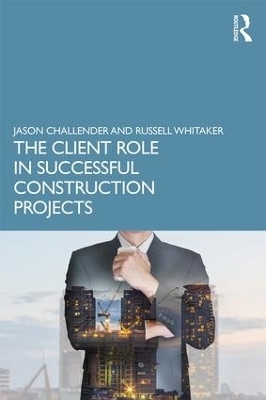
The Client Role in Successful Construction Projects
Routledge (Verlag)
978-1-138-05821-7 (ISBN)
Understand the challenges that they and the project are likely to face.
Communicate and interact effectively with key stakeholders and professionals within the industry.
Understand in straightforward terms where they can have a positive impact on the project.
Put in place a client-side due diligence process.
Reduce their institutional risk and the risk of project failure.
Discover how their standard models are able to co-exist and even transfer to a common client-side procedure for managing a construction project.
Written by clients, for clients, this book is highly recommended not only for clients, but for construction industry professionals who want to develop their own skills and enhance their working relationship with their clients. A supporting website for the book will be available, which will give practical examples of the points illustrated in the book and practical advice from specialists in the field.
Jason Challender has acquired nearly 30 years’ client-side experience in the UK construction industry and procured numerous successful major construction programmes during this time. He is Director of Estates and Facilities at the University of Salford, a member of its Senior Leadership Team and is responsible for overseeing a large department of approximately 350 estates and construction related staff. He is also a construction researcher with ten published academic journal and conference papers in recent years, all of which have been dedicated to his studies around trust and collaborative procurement in the construction industry. Furthermore, he has previously participated as a book reviewer for Wiley. He has also attended many national construction and institutional conferences as a guest speaker over the years and is a Fellow and Board Director of the Royal Institution of Chartered Surveyors. Russell Whitaker is a Chartered Surveyor, an engineer and construction purchasing specialist and runs his own practice in Guildford. Russell was a senior executive and former Vice Principal in many public and private organisations with over 30 years’ managing complex multi-faceted development and construction projects and facilities staff before starting his own property consultancy. He has advised many prestigious clients including Southbank Arts Centre, Royal Botanic Gardens Kew and currently the Royal Automobile Club on project initiation, pre-development and procurement. Russell has strong academic links as a Visiting Lecturer and Course Leader for over 20 years in Building Project Management and Procurement and Professional Project Management at the Sir John Cass Business School, City University. He is a conference speaker specialising in the client role in managing 'front-end' project risk.
Contents
Author biographies
Foreword by Brigadier Miles Wade CBE
Foreword by Professor Peter McDermott FRICS PhD
Preface
Acknowledgements
List of Figures
List of Tables
Part One: An introduction into the Construction Industry and Construction Clients by Dr Jason Challender
1. Introduction
References
2. A model of construction clients and their projects
2.1 Clients and the process of construction
2.2 The ‘client voice’
2.3 The complexity of clients
2.4 Client requirements through project briefs
2.5 The transformational nature of client projects
2.5.1 Buildings, organisational and human considerations
2.5.2 Organisational changes in clients brought about through projects
2.6 Project and client requirements
2.6.1 Understanding the businesses of construction clients
2.7 Summary of chapter
References
3. The unique role of clients in the context of the construction industry
3.1 The bespoke nature of the construction industry
3.2 The construction Industry and recent reforms
3.3 The involvement of clients in the procurement of design and construction services
3.3.1 Traditional procurement of construction projects; barriers and problems
3.3.2 Deficiencies with traditional construction procurement
3.4 Overall context of collaborative working and partnering within the construction industry
3.5 Alternative procurement methods for clients on construction projects
3.5.1 Government context; reports, codes of practice and recommendations for change
3.5.2 Industry and professional context
3.6 Summary
References
4. The importance of leadership for construction clients
4.1 Introduction to chapter
4.2 Leadership Identity and relevance for construction clients
4.3 Leadership challenges for construction clients
4. 4. Keys components of leadership for construction clients
4.5 Leadership styles as applied to construction clients
4.6 The importance of communication for construction clients in leadership
4.7 Adaptability of leadership styles for construction clients
4.8 The relationship between poor client leadership and project failure
4.9 Summary
References
5. Governance considerations for construction clients
5.1 Introduction to chapter
5.2 Project controls
5.3 The importance of project/programme boards
5.4 Gateway processes for project approval and business cases
5.5 Summary of chapter
References
6. Selection and appointment processes for construction clients
6.1 Introduction to chapter
6.2 The importance of the contractor selection process
6.3 Articulation of the problem for selecting contracting partners from the perspective of construction clients
6.4 A historical perspective of the problem
6.5 Risk
6.6 Benchmarking
6.6.1 Key performance indicators
6.6.2 Constructionline
6.6.3 Centralised KPI sharing systems
6.6.4 Common prequalification practices
6.7 Prequalification models and methodologies
6.7.1 Multi-criteria model
6.7.2 Fuzzy set model
6.7.3 Financial Model
6.8 Designing a new way for construction clients to select their contracting partners
6.9 The quality of prequalification processes and their influence on project success
6.10 Summary and conclusions
6.10.1 Determination of whether quality of prequalification processes by construction clients influences project success.
6.10.2 Determination of whether construction clients’ current prequalification practices are sufficient to identify and select collaborative contractors
6.10.3 Determination of the extent to which construction clients are using objective assessments of KPIs to short-list contractors for tenders
6.10.4 Potential recommendations and drivers for change and improvement
References
7. The ‘Intelligent Client’; a model of procurement built on relationship management between construction clients and the supply chain
7.1 Introduction to chapter
7.2 What do we mean by collaborative strategies?
7.3 An awareness for construction clients on issues around collaborative procurement strategies and trust
7.4 Trust as a collaborative necessity for construction clients
7.5 Potential benefits of trust for construction clients; incentives to trust
7.6 Research findings and discussion
7.6.1 Quantitative analysis: questionnaire data
7.6.2 Qualitative analysis: Interview data
7.7 Implications for construction client in managing requirements and expectations for collaboration and trust
7.8 Conclusions and recommendations
References
8 Critical success factors for construction clients
8.1 Introduction
8.2 The articulation of the problem for construction clients
8.3 Understanding what skills construction clients require
8.4 Success criteria on projects for construction clients
8.5 Research study to identify the success factors for construction clients
8.6 Analysis and reflection of the study on critical success factors for construction clients
8.6.1 Human skills versus technical skills for construction clients; Human skills
8.6.2 Human skills versus technical skills for construction clients; Technical skills
8.6.3 Collaboration and common objectives
8.6.4 Environment and external factors
8.6.5 Determining the right balance between hard and soft skills for the success of construction clients
8.7 The key human skills that influence the performance of construction clients
8.8 The importance of individual qualities of construction clients for projects success
8.9 Summary of chapter
References
9. The relevance of professional ethics for construction clients
9.1 Introduction to chapter
9.2 What are professional ethics?
9.3 The importance of professional ethics for construction clients
9.4 Codes of ethics for construction clients
9.5 How should construction clients recognise unethical practices?
9.6 The need for construction clients to uphold cultural values when procuring projects
9.7 Governance and regulation of professional ethics
9.8 Environmental ethics
9.9 Summary and conclusions
References
10. The influence of construction clients on motivating project teams
10.1 Why should construction clients be concerned about project team motivation?
10.2 The bespoke and unique nature of the construction industry
10.3 Factors which affect motivation levels of project teams
10.4 Communication as a motivational factor
10.5 The benefits of training and education
10.6 Cultural factors affecting levels of motivation for construction related staff
10.7 The use of financial incentives as a motivational management tool
10.8 Summary and conclusion
References
11. Developing a construction client toolkit, as a practical guide for managing projects
11.1 Introduction to chapter
11.2 Planning and devising the toolkit
11.3 Feedback and evaluation of the toolkit from the perspectives of construction clients
11.4 Ensuring and monitoring performance throughout the life of projects; General project directory and checklist
11.5 The documentation that construction clients need to consider at pre-construction stages
11.5.1 Contractor prequestionnaires for competency and compliance
11.5.2 Monitoring checklist required for document control and processes
11.5.3 Permits to work and making contractors aware of known hazards
11.6 Managing documentation and construction processes following the appointment of contractors
11.6.1 Project execution plan
11.6.2 Contractors’ handbooks and codes of conduct
11.7 The documentation and processes that construction clients need to consider in the construction phases of projects
11.7.1 The importance of monthly project reporting for construction clients
11.8 The documentation and processes that construction clients need to consider in the post-construction phases of projects
11.8.1 Managing handover; project handover checklists and test certification
11.8.2 Capturing lessons learnt on projects
11.9 Conclusion
References
12. Reflections, overview and summary of key points of Part One
12.1 Overall summary and recommendations
Appendices
Appendix A Project proposal (Gateway 1)
Appendix B Business case (Gateway 3) template
Appendix C Example of a partnering charter
Appendix D Example of a contractor competency questionnaire
Appendix E Example of a health and safety contractor’s handbook
Appendix F Example of a project execution plan (PEP)
Part Two: A Construction Risk Management Model for Construction Clients
13. Executive Summary Briefing
14. Construction clients, Business Propositions and Corporate Construction Risk.
14.1 The Construction Client.
14.2 Construction Clients and Value Propositions.
14.3 Client and Construction Team Behaviours.
14.3.1 Client Behaviour in Project Development.
14.3.2 Design Team Behaviour in Design and Construction.
14.3.3 Client Behaviour in Design and Construction.
14.3.4 Client Behaviour in RIBA Outline Plan of Work.
14.4 Risk Management Principles for Clients in Construction.
14.4.1 Corporate Construction Risk.
14.4.2 Managing Corporate Construction Risk.
14.4.3 The Professional Clients Framework.
14.5 Summary: The Need for a Professional Construction Client.
References
15. Unique Client Contributions to Construction.
15.1 Preamble.
15.2 The Professional Construction Client.
15.3 The Four Unique Contributions a Client can make to a Construction Client.
15.3.1 Contribution 1: Clarity in Purpose, Value Propositions (Outline Business Case, Objective Setting, Cashflow Optioneering, Business Case Refinement).
15.3.2 Contribution 2: Realism and Flexibility in Operational Planning and Change (Work Package Agreement Configuration, Pestle Analysis, Stakeholder Alignment).
15.3.3 Contribution 3: A Strong and Consistent Client Voice in Design and Production Stage (Client Requirements, Design Negotiations, Develop Design Implications Report).
15.3.4 Contribution 4: Balanced Management of Change and Corporate Risk throughout Asset Delivery and Stabilisation A Strong and Consistent Client Voice in Design and Production Stage (Client Requirements, Design Negotiations, Develop Design Implications Report).
15.4 Project Success and Client Satisfaction.
15.5 Summary: The Client as a Unique Contributor To Project Success.
References
16. Reducing Corporate Risk Using the Construction Risk Management Model.
16.1 Risk, Construction and Clients.
16.2 Client Contributions to Risk Reduction.
16.3 Navigating around the Client-Side Construction Enterprise Risk Management (CERM) Model.
16.4 Summary: Managing Risk using Our Client-side Risk Management Model.
16a. Business Concept Development Stage
16a.1 Purpose
16a.2 Organisations and Planning
16a.3 Planned Change and Managed Impact
16a.4. Why Construction Change is Different
16a.5 Business Concept Development Stage Outputs
16a.6 Job Book: Business Concept Development
16a.6.1 Corporate Vision Outputs
16a.6.2 Corporate Construction Risk Mitigation Outputs
16a.7 Summary: Business Concept Development Stage.
16b. Corporate Client /Delivery Capability/Transformation Stage
16b.1 Purpose
16b.2 Corporate Client Delivery Capability
16b.3 Job Book: Corporate Client /Delivery Capability/Transformation Stage
16a.3.1 Operational Planning Outputs
16b.4 Summary: Corporate Client /Delivery Capability/Transformation Stage
16c. Outcomes Delivery Stage
16c.1 Purpose
16c.2 Outcomes Delivery Stage.
16c.3 Job Book: Outcomes Delivery Stage
16c.4 Preparing for Design Stage, Benchmarking and Design Liability
16c.5 Appointment of contractors and start on site
16c.6 Summary: Outcomes Delivery Stage
16.d Three Year In- Stage
16d.1 Purpose
16d.2 Job Book: Three Year -In Stage.
16c.2.1 Asset Delivery Aftercare and Management Outputs
Part One: Asset Handover Management Planning
Part Two: Post Operational Review
16c.3 Summary: Three Year -In Stage.
17. Key Points: Client Risk Management and the Risk Management Model
Appendices
Appendix 2A Client Risk Management Model
Appendix 2B RIBA Outline Plan of Work
Index
| Erscheinungsdatum | 10.05.2019 |
|---|---|
| Zusatzinfo | 44 Tables, black and white; 34 Line drawings, black and white; 2 Halftones, black and white |
| Verlagsort | London |
| Sprache | englisch |
| Maße | 156 x 234 mm |
| Gewicht | 453 g |
| Themenwelt | Technik ► Bauwesen |
| Wirtschaft ► Betriebswirtschaft / Management ► Rechnungswesen / Bilanzen | |
| Betriebswirtschaft / Management ► Spezielle Betriebswirtschaftslehre ► Immobilienwirtschaft | |
| ISBN-10 | 1-138-05821-1 / 1138058211 |
| ISBN-13 | 978-1-138-05821-7 / 9781138058217 |
| Zustand | Neuware |
| Informationen gemäß Produktsicherheitsverordnung (GPSR) | |
| Haben Sie eine Frage zum Produkt? |
aus dem Bereich


